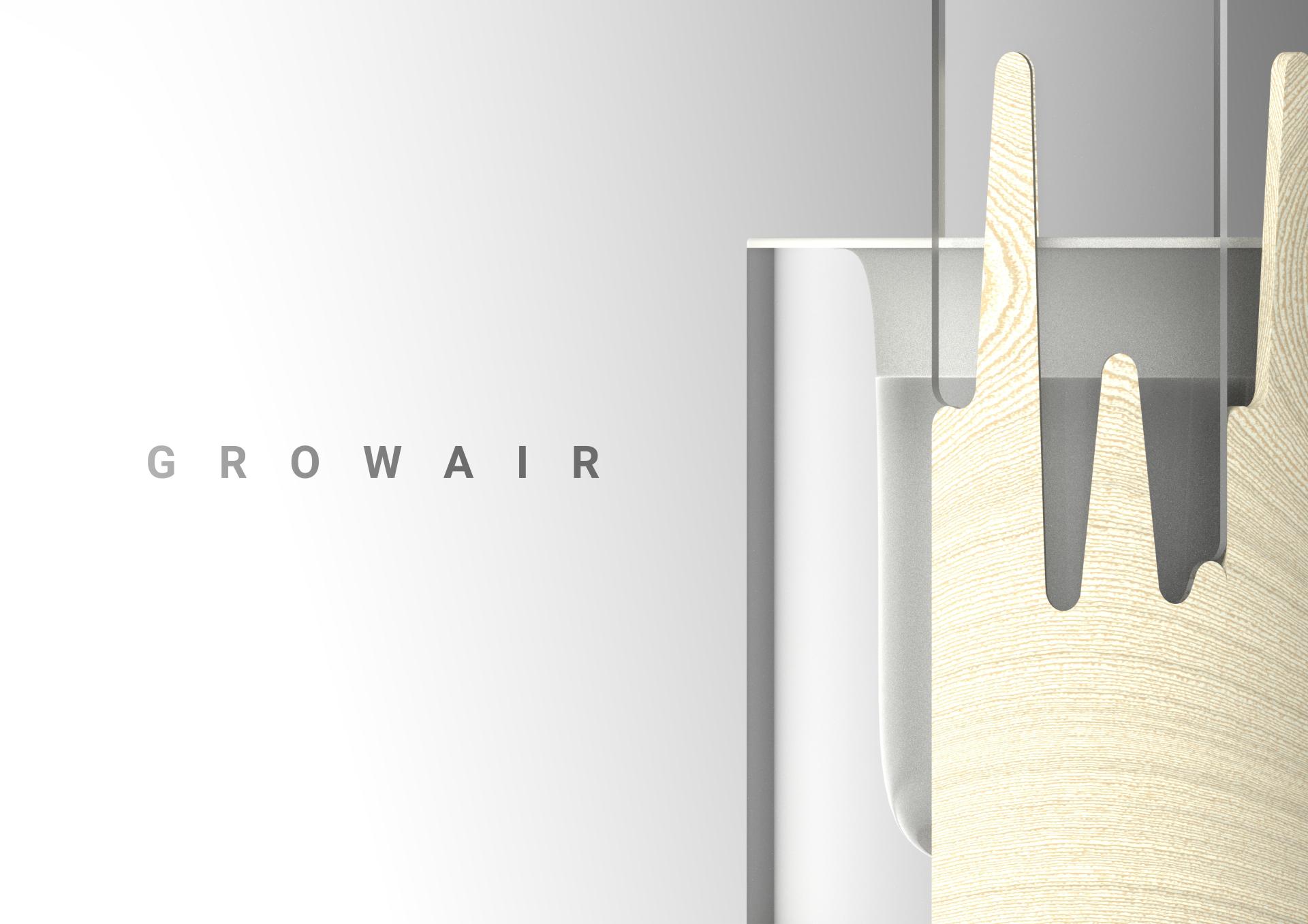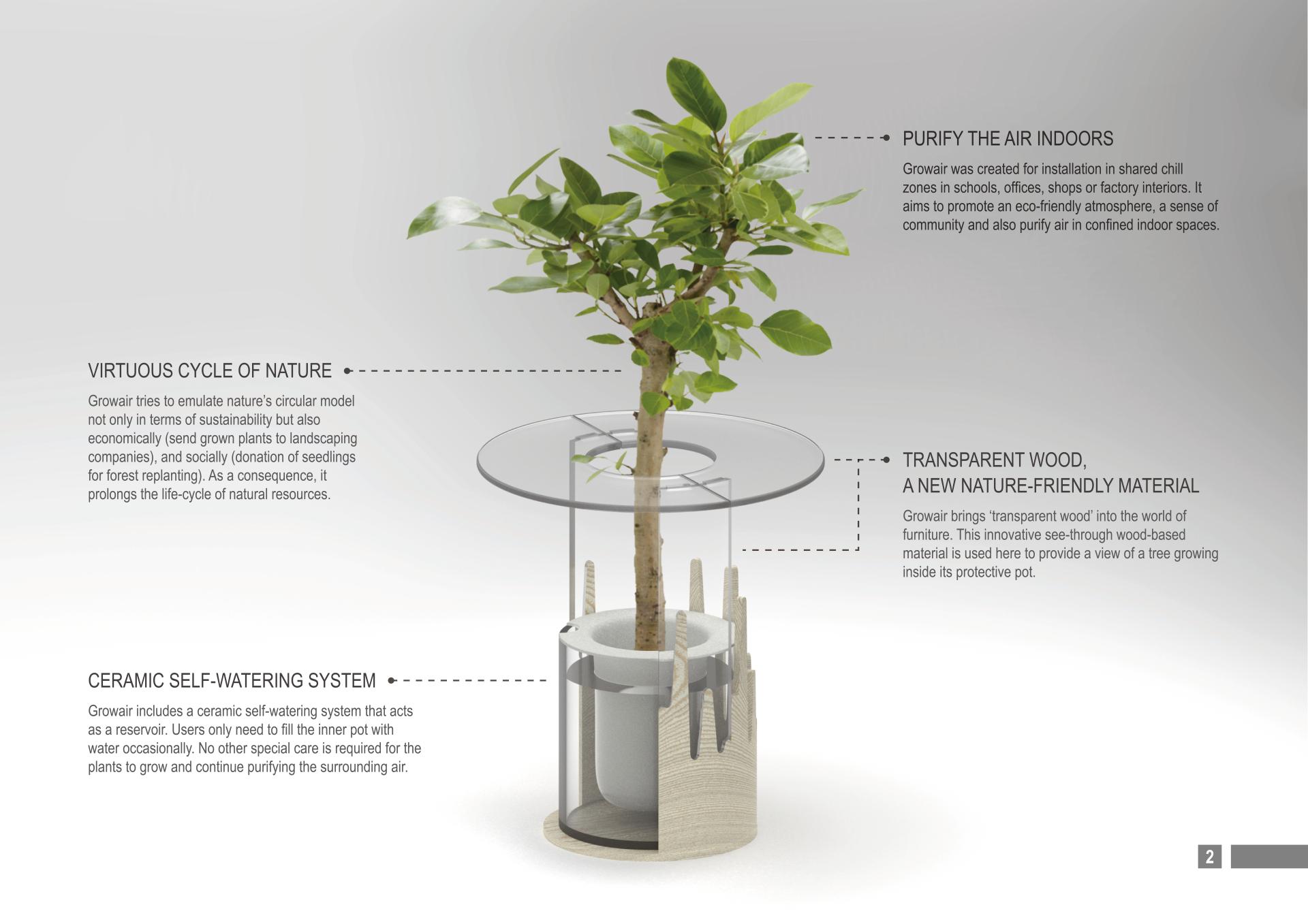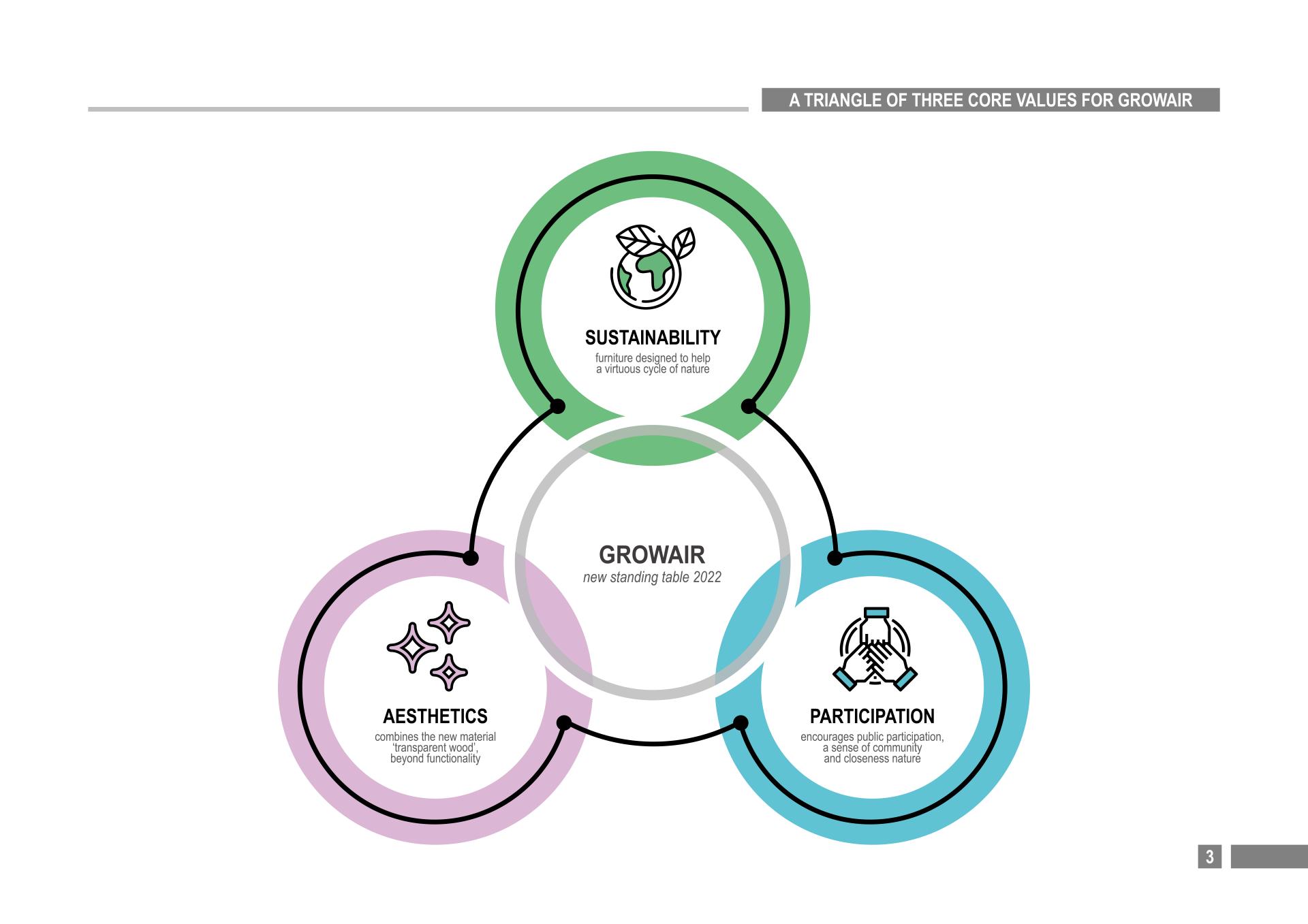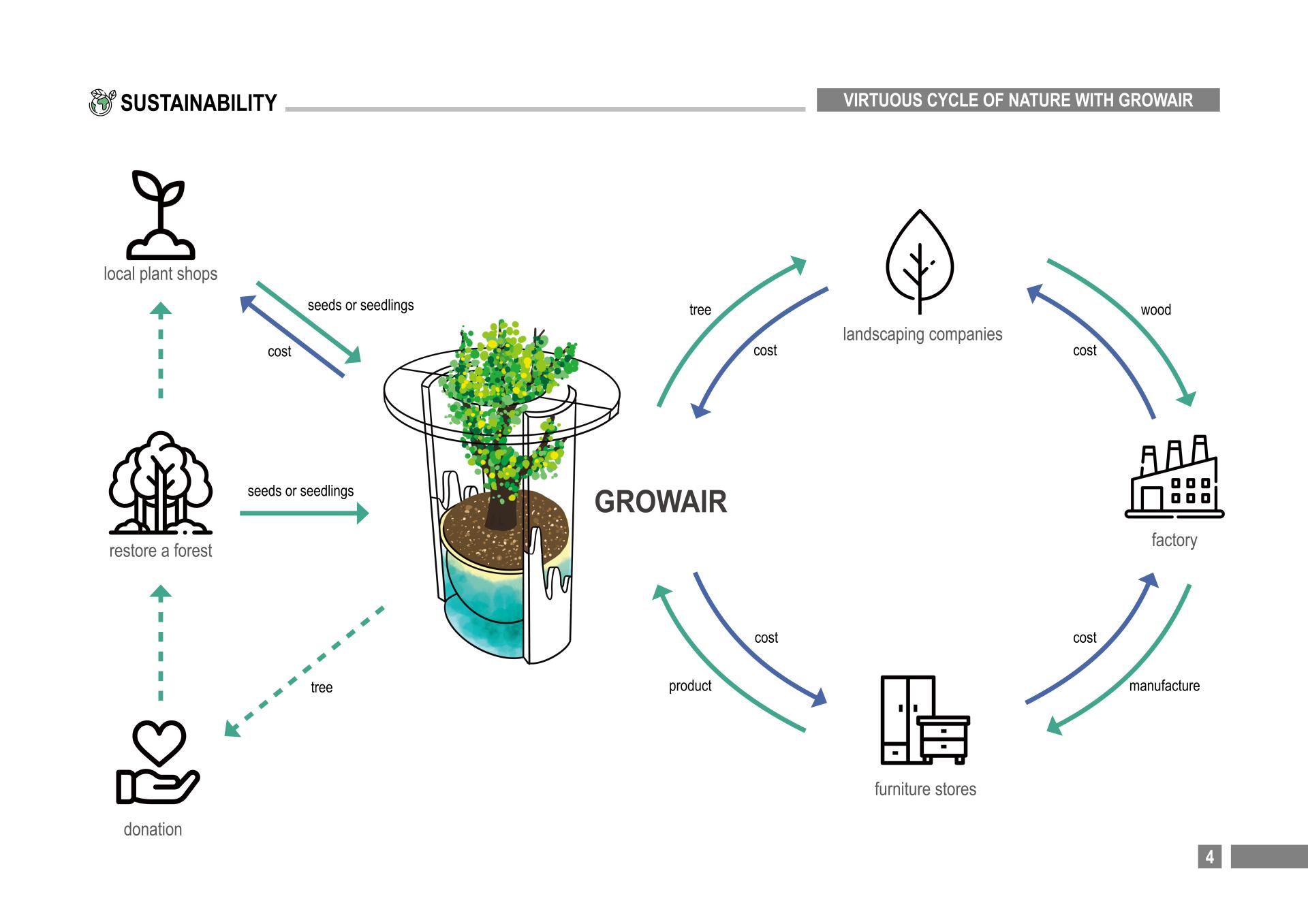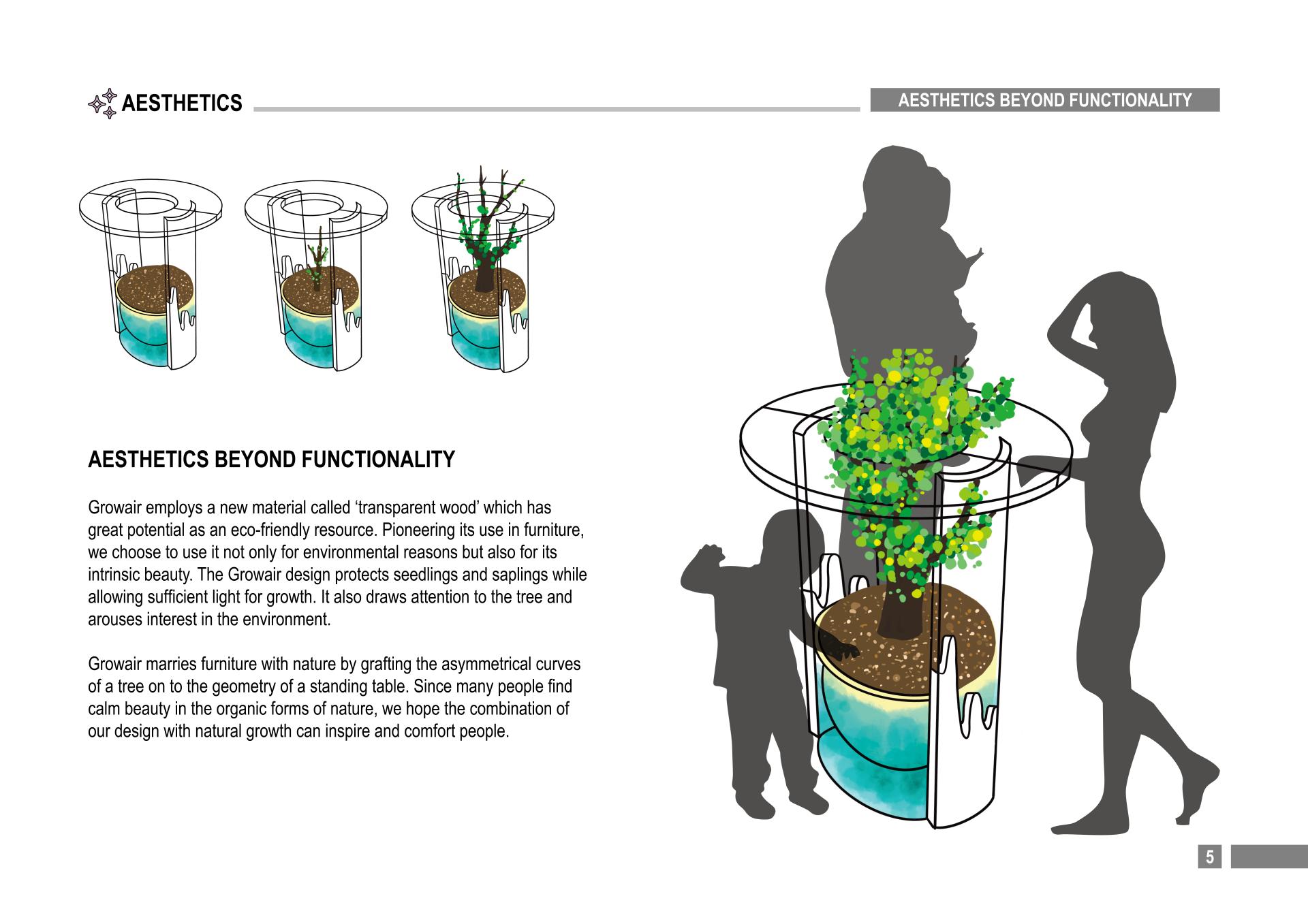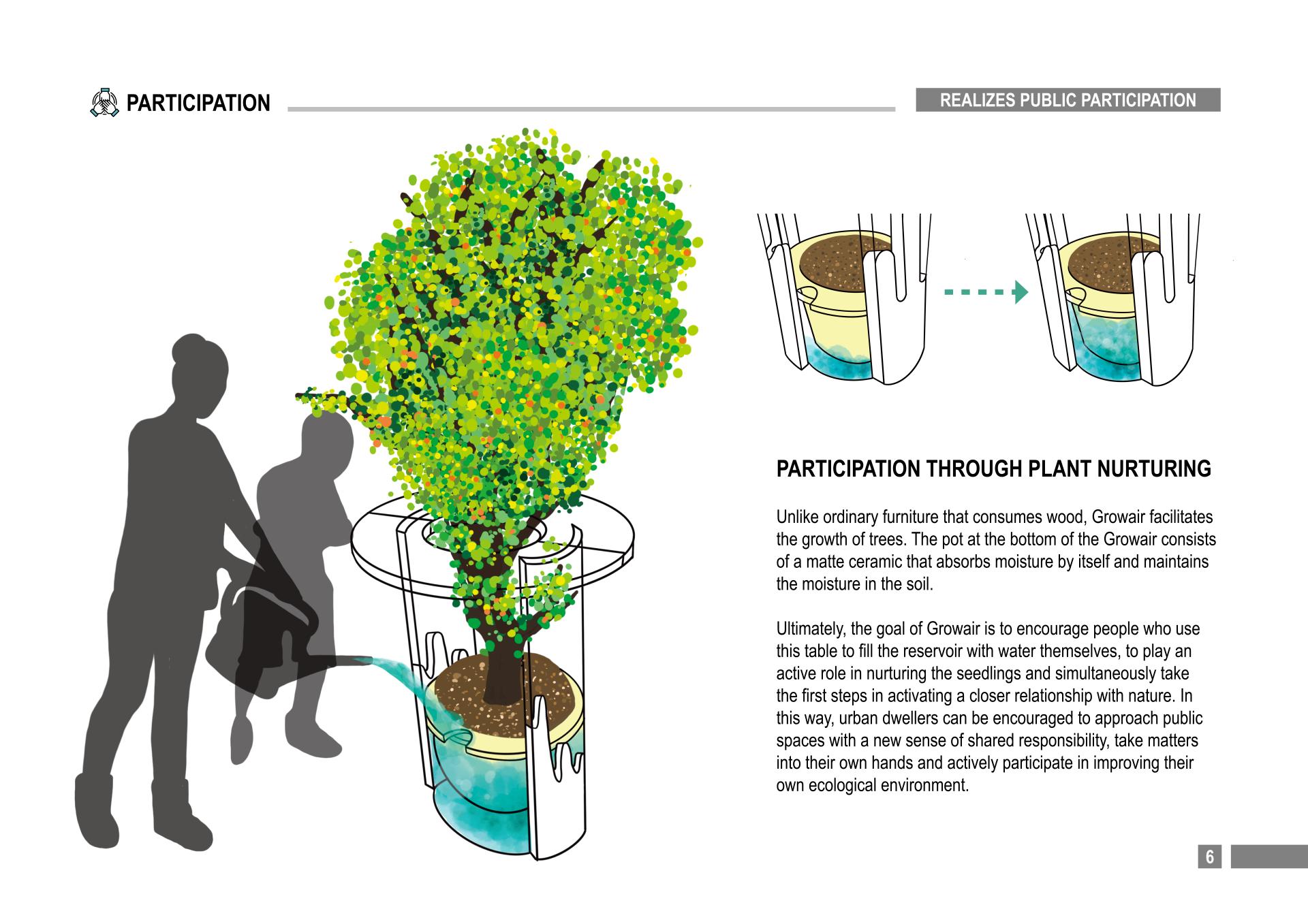Growair
Basic information
Project Title
Full project title
Category
Project Description
Turn office furniture into a tree nursery! Growair features innovative transparent wood to construct a standing-height table for interior chill-out zones. The sustainable design incorporates a self-watering ceramic plant pot to grow your own tree which can then be donated to aid reforestation. While growing, the tree helps purify ambient air in a working environment and encourages beneficial awareness of ecological responsibility in daily life.
Geographical Scope
Project Region
Urban or rural issues
Physical or other transformations
EU Programme or fund
Which funds
Description of the project
Summary
- Growair seeks a new direction in sustainable design through furniture that encourages mutually beneficial human and plant interactions.
-
The design features an innovative eco-friendly material called ‘transparent wood’, plus structures made of wood, and ceramics. Its self-watering system relies on a specially developed porous ceramic vessel that provides an ample capacity of water to keep the plants growing and purifying the surrounding air.
-
Growair is designed for common spaces and rest areas in urban buildings. It fosters environmental awareness and a sense of belonging by creating a space where the community can come together.
-
Users are encouraged to take responsibility for caring for the plants. They fill the outer pot with water when it is empty and naturally start observing the growth of the plants. This interactive process we hope will spark awareness of the natural environment and breed greater involvement in its well-being.
-
In addition, once seedlings have grown to certain size they are intended to be donated to help replant forests, for example after wildfires. The trees might also find their way onto local markets. Hopefully this will contribute to establishing a more virtuous life-cycle and stimulate the local economy.
- Restoring forestland has a positive influence on improving the general environment. Donating more trees would accelerate reforestation in countries around the world and slow the effects of global warming. Perhaps some of these trees will be cut down for timber and later become pieces of furniture once again.
Key objectives for sustainability
Growair is a piece of furniture designed to help the virtuous cycle of nature. Most existing pieces of furniture that are combined with plants are designed for growing low maintenance cactuses or succulents that require little watering. Among systems for other types of plants, it is hard to find furniture that facilitates plant growth or actively confronts environmental concerns. Our design addresses these issues by incorporating the entire cycle of receiving seeds and seedlings from local plant shops, nurturing and growing them, and then donating them to landscaping companies, to wildfire areas or plantations that need more trees to maintain a level of ecological continuity after logging.
A case in point, climate-induced increasingly frequent and devastating wildfires in Australia and California have become an international issue. The donation of seedlings and trees is desperately called for to restore destroyed forests, and Growair, if widely adopted, has the potential to help in areas or circumstances that require fast replanting of trees.
The cycle meets environmental, economic (send grown plants to landscaping companies), and social (donation of seedlings for forest reconstruction) needs, and as a consequence, it enables the continued use of natural resources. Normally, furniture-making only consumes trees and does not focus on growing them. Growair can therefore provide an original solution and contribute to new models of sustainability and circular ecological economies.
We hope Growair can be installed in many schools and workplaces in France and maybe in other countries, so that trees that start their lives indoors can be donated to areas of land that need replanting.
Key objectives for aesthetics and quality
Growair introduces into furniture design a novel environmentally-friendly material called ‘transparent wood’. This specific material, in which light and shadow are closely expressed according to the movement of the sun, brings Growair one step closer to the theme of nature. In addition, transparent wood has the advantage of having significant potential as a desirable building material because it produces less pollution, unlike common current materials that are harmful to the environment such as glass and acrylic.
In Growair, the transparency of this material allows people unhindered observation of a growing tree, focussing attention on its natural beauty. This we hope will instil a greater sense of belonging to nature and encourage more people to make improving the environment a personal goal. In terms of shape, Growair creates a hybrid between furniture and nature by grafting the irregular and asymmetrical lines of a living organism onto to the simpler geometry of a standing table.
Since many people see beauty and stability in the irregular smooth curves of nature, combining furniture and tree shapes can inspire and comfort users.
Providing a small, planted space indoors where people can meet creates unconscious associations with the pleasures of a natural environment and may increase sensitivity to or involvement in preservation of plant diversity in a broader context outside the building’s walls.
Key objectives for inclusion
Unlike normal furniture that consumes wood from trees, Growair is furniture designed to put trees back in the environment as well as nurture local communities and interact with businesses. Trees grown from seedlings in Growair can be donated to restock land damaged by wildfire, or sent to landscaping companies to facilitate another virtuous economic cycle.
Firstly, Growair buys seeds or seedlings from local plant shops. Users care for the trees until they become too big for their pot, at which point they can donate or sell them to local landscaping companies or forest owners. After many years growing in a forest, the wood from fully mature trees is sold on to lumber merchants and factories some of which manufacture furniture products which find their way back to the consumer. Alternatively, some trees will be donated directly to replant commercial or public forest land. As forests recover and nature comes back to life, we will obtain seeds and seedlings again. This is an example of economic cooperation and a regional cooperative project envisioned by Growair. We hope to nurture nature and the local economy with Growair.
The pot incorporated in the Growair consists of a matte ceramic material specially developed to absorb moisture and maintain humidity levels in the soil. The goal of Growair is to encourage people who use this table to take responsibility for occasionally filling the reservoir with water and so participate in growing the seedlings. We believe users will quickly enjoy the pleasures of raising plants, learn more about the process and gain a greater sense of connection with nature.
Physical or other transformations
Innovative character
First of all, "sustainability" is a primary concern of all the materials used in making the design; clay, transparent wood and carefully resourced other types of wood. Sustainability and persistence of a stable virtuous cycle is also the main tenet of our project. We create a holistic cycle that starts with donated seeds which are then planted and cultivated by members of the public in a design that brings plant seedlings into a working environment and encourages care and responsibility for their growth. Having attained a certain size, the young trees can then be donated or sold to local landscaping companies or donated directly to areas where forests need replanting due to wildfire damage or programmed logging. Gradually a stable virtuous cycle can be established that combines the efforts of individuals, local communities and businesses in a natural way.
“Aesthetics beyond function” is integral to our choice of “Transparent wood”, an ecologically viable see-through material we use to make interior furniture. Its attractive texture, the play of light, shadow and reflections immediately stimulated our interest and creative imagination. We use the material as a poetic vision of the versatility of wood, looking through wood to observe and protect a young tree growing.
“Public participation”, is vital for Growair. Our design and its placement in schools and workplaces solicits the collaboration of users who must take responsibility for watering and nurturing a growing tree. In jointly growing plants, it is possible to feel a sense of belonging to nature and a common collective effort. Donating the tree for replanting in damaged or fragile landscapes extends this solidarity to include the survival of communities and local economies.
In other words, all three aspects exist in Growair with the same purpose, fostering a sense of belonging, connection, and intimacy with nature and consequently arousing interest in protecting the environment.

